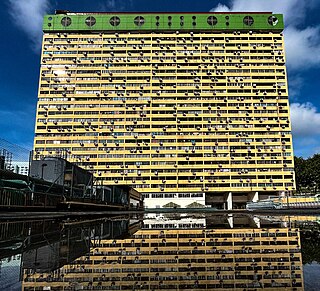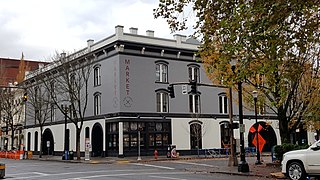
Japanese cuisine encompasses the regional and traditional foods of Japan, which have developed through centuries of political, economic, and social changes. The traditional cuisine of Japan is based on rice with miso soup and other dishes; there is an emphasis on seasonal ingredients. Side dishes often consist of fish, pickled vegetables, and vegetables cooked in broth. Seafood is common, often grilled, but also served raw as sashimi or in sushi. Seafood and vegetables are also deep-fried in a light batter, as tempura. Apart from rice, a staple includes noodles, such as soba and udon. Japan also has many simmered dishes, such as fish products in broth called oden, or beef in sukiyaki and nikujaga.
Yaohan Co., Ltd. or Yaohan; Chinese: 八佰伴) was a Japanese retail group, founded in 1930 by Ryohei Wada and his wife Katsu Wada. Initially a single shop, it was expanded by their son Kazuo Wada into a major supermarket chain with most retail outlets located in Shizuoka prefecture, south of Tokyo. It was incorporated in 1948 and listed on Tokyo Stock Exchange. The store was far more established and notable outside Japan, due to restrictive laws in Japan that made it difficult to set up new businesses, such that by the time it opened its first store in the Tokyo metropolitan area, the company was already in a state of decline due to accumulated debts from over-expansion.

99 Ranch Market is an American supermarket chain owned by Tawa Supermarket Inc., which is based in Buena Park, California. 99 Ranch has 58 stores in the U.S., primarily in California, with other stores in Nevada, Oregon, Washington, New Jersey, Texas, Maryland, Massachusetts, Arizona, and Virginia. The company also started offering shopping via its website in 2014. In February 2021, the company also launched their mobile app for grocery delivery.

T&T Supermarket is a Canadian supermarket chain that sells primarily Asian foods. The company is headquartered in Richmond, British Columbia. In 1993, the first T&T was opened in Burnaby's Metropolis at Metrotown, a shopping centre in the Metrotown area in the Greater Vancouver region. As of 2014, T&T's CEO is Tina Lee, who succeeded her mother Cindy Lee.

In non-Asian countries, an Asian supermarket largely describes a category of grocery stores that focuses and stocks items and products imported from countries located in the Far East.

Wing Yip is a Chinese supermarket chain founded by Woon Wing Yip in England in 1970. The original Birmingham store now also serve as its headquarters, international trading division, property investments, online store, warehouse, and national distribution centre. The company has superstore branches in Manchester, Croydon and Cricklewood.

Liverpool ONE is a shopping, residential, and leisure complex in Liverpool, England. The project involved the redevelopment of 42 acres of land in the city centre. It is a retail-led development anchored by the department store John Lewis. Debenhams had previously been an anchor tenant until the closure of its Liverpool One store in March 2021, with Marks & Spencer due to take its place in mid-2023. Additional elements include leisure facilities, apartments, offices, public open spaces, restaurants, and transport improvements. The completion of Liverpool ONE significantly boosted the local economy, while lifting Liverpool into the top five most popular retail destinations in the UK.

Mitsuwa Marketplace is a Japanese supermarket chain in America, with locations in California, Illinois, Texas, Hawaii, and New Jersey.
YO! Sushi is a company that owns, operates, and franchises conveyor belt sushi restaurants, principally in the United Kingdom, Republic of Ireland, United Arab Emirates, Saudi Arabia, Bahrain, Kuwait and Australia.

Hong Kong Sceneway Plaza, SCENEWAY PLAZA is a shopping centre in Lam Tin, Kowloon, Hong Kong. It also contains the East Kowloon Office of the Immigration Department. Opened in February 1992, the shopping centre is located adjacent to Lam Tin station of Hong Kong's Mass Transit Railway (MTR). The plaza, which used to be a Japanese department store called Yaohan, contains many small stores including fashion, stationery, and music shops.

People's Park Complex is a high-rise commercial and residential building in Singapore, situated in Park Road off Eu Tong Sen Street in Outram, within People's Park and next to Chinatown MRT station.

Ippudo, also known as Hakata Ippūdō (博多一風堂) in Japan, is a Japanese ramen restaurant chain with locations worldwide. Ippudo is well known for its tonkotsu ramen, and has been described as "the most famous tonkotsu ramen shop in the country".

Pacific Werribee is a major regional shopping centre located in the suburb of Hoppers Crossing, approximately 29 kilometres (18 mi) south-west of the Melbourne Central Business District (CBD) in Victoria, Australia.

Japanese nationals residing in London, in common with members of the wider Japanese community in the United Kingdom, include business professionals and their dependents on limited term employment visas, trainees, young people participating in the UK government sponsored Youth Mobility Scheme, students, as well as Japanese emigrants and their descendants who have settled in the city.
Thomson Plaza, formerly unofficially called Thomson Yaohan, is a suburban shopping mall located along Upper Thomson Road, in Singapore. Opened in 1979, Thomson Plaza is best known for having a Yaohan departmental store in the 1980s and 1990s.

Pine Street Market is a food hall in the United Carriage and Baggage Transfer Building in the Old Town Chinatown neighborhood of Portland, Oregon, curated by Feast Portland co-founder Mike Thelin. The building's renovation cost $5 million. The market opened in April 2016.

Katsu Burger is a Japanese-themed burger restaurant chain in the Seattle metropolitan area, in the U.S. state of Washington.



















